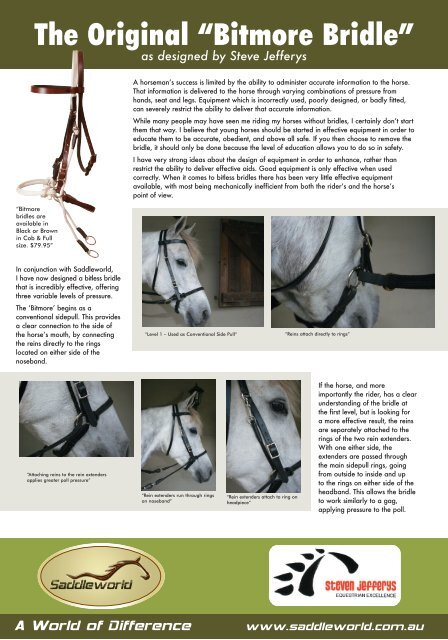The Original “Bitmore Bridle” - Ascot Saddlery
The Original “Bitmore Bridle” - Ascot Saddlery
The Original “Bitmore Bridle” - Ascot Saddlery
Create successful ePaper yourself
Turn your PDF publications into a flip-book with our unique Google optimized e-Paper software.
<strong>The</strong> <strong>Original</strong> <strong>“Bitmore</strong> <strong>Bridle”</strong><br />
as designed by Steve Jefferys<br />
<strong>“Bitmore</strong><br />
bridles are<br />
available in<br />
Black or Brown<br />
in Cob & Full<br />
size. $79.95”<br />
In conjunction with Saddleworld,<br />
I have now designed a bitless bridle<br />
that is incredibly effective, offering<br />
three variable levels of pressure.<br />
<strong>The</strong> ‘Bitmore’ begins as a<br />
conventional sidepull. This provides<br />
a clear connection to the side of<br />
the horse’s mouth, by connecting<br />
the reins directly to the rings<br />
located on either side of the<br />
noseband.<br />
“Attaching reins to the rein extenders<br />
applies greater poll pressure”<br />
A horseman’s success is limited by the ability to administer accurate information to the horse.<br />
That information is delivered to the horse through varying combinations of pressure from<br />
hands, seat and legs. Equipment which is incorrectly used, poorly designed, or badly fitted,<br />
can severely restrict the ability to deliver that accurate information.<br />
While many people may have seen me riding my horses without bridles, I certainly don’t start<br />
them that way. I believe that young horses should be started in effective equipment in order to<br />
educate them to be accurate, obedient, and above all safe. If you then choose to remove the<br />
bridle, it should only be done because the level of education allows you to do so in safety.<br />
I have very strong ideas about the design of equipment in order to enhance, rather than<br />
restrict the ability to deliver effective aids. Good equipment is only effective when used<br />
correctly. When it comes to bitless bridles there has been very little effective equipment<br />
available, with most being mechanically inefficient from both the rider’s and the horse’s<br />
point of view.<br />
“Level 1 – Used as Conventional Side Pull” “Reins attach directly to rings”<br />
“Rein extenders run through rings<br />
on noseband”<br />
“Rein extenders attach to ring on<br />
headpiece”<br />
If the horse, and more<br />
importantly the rider, has a clear<br />
understanding of the bridle at<br />
the first level, but is looking for<br />
a more effective result, the reins<br />
are separately attached to the<br />
rings of the two rein extenders.<br />
With one either side, the<br />
extenders are passed through<br />
the main sidepull rings, going<br />
from outside to inside and up<br />
to the rings on either side of the<br />
headband. This allows the bridle<br />
to work similarly to a gag,<br />
applying pressure to the poll.<br />
A World of Difference www.saddleworld.com.au
<strong>The</strong> <strong>Original</strong> <strong>“Bitmore</strong> <strong>Bridle”</strong><br />
<strong>The</strong> third and the most effective option of the ‘Bitmore’ bridle is achieved by passing the rein extenders through the side pull ring on<br />
the noseband, under the jaw and up to the ring on the opposite side of the headband. At this point the bridle is applying pressure<br />
to the poll, nose and jaw, in an extremely effective manner.<br />
“<strong>The</strong> crossover action applies<br />
pressure to poll, nose and jaw”<br />
For the ‘Bitmore’ to work<br />
effectively it must be fitted<br />
correctly. At all three levels<br />
the most important factor is the<br />
noseband. It should sit just above<br />
the horse’s mouth on the bridge<br />
of the nose. In this position it<br />
should be adjusted to be<br />
comfortable, like a wrist watch.<br />
It should not be loose, where it<br />
can move up and down on the<br />
nose, but certainly not tight<br />
where it applies a constant<br />
unavoidable pressure (about one<br />
millimeter of clearance). At levels<br />
two and three, the ‘Bitmore’ allows the rider to progressively apply simultaneous pressure to the horse’s nose and poll. This pressure<br />
is created by the action of the noseband and the headband being drawn together, without the noseband being allowed to slide up<br />
the horse’s nose.<br />
<strong>The</strong> important thing to<br />
remember with this or any<br />
other training device, is the<br />
equipment is only as good<br />
as the person using it and if<br />
you don’t understand how it<br />
works, don’t use it until you<br />
do!<br />
It is easy to increase the<br />
pressure on a horse, but it is<br />
the timing of the ‘release’<br />
that determines your<br />
success.<br />
Steven Jefferys<br />
“Rein extenders pass through rings on nosepiece,<br />
pass underneath the jaw and attach to ring on<br />
headpiece on the opposite side.”<br />
“Noseband should be fitted firmly,<br />
positioned two fingers width<br />
below the cheek bone”<br />
“A correctly fitted noseband will ensure the bridle does<br />
not ride up when pressure is applied to the reins”<br />
“……whoever does the most homework wins”<br />
A World of Difference www.saddleworld.com.au


